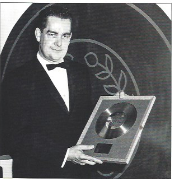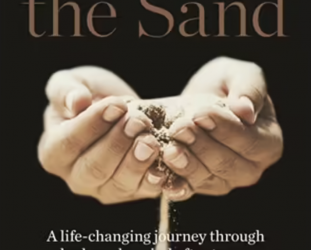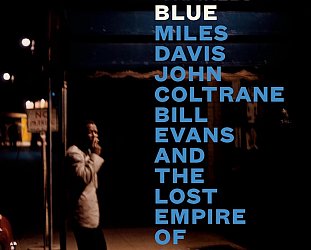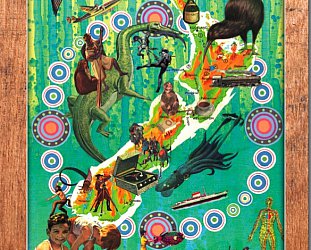Graham Reid | | 4 min read

Take that of Eldred Stebbing, a man in the vanguard of many aspects of the New Zealand recording and music industry, who died a decade ago next month at age 88.
He was born when air travel was in its infancy, movies were silent, there were market gardens around Avondale where he lived and Auckland's population was about 120,000.
The biggest city in the country was the size of Dunedin today, and hardly anyone lived in what we call the North Shore.
In those early decades of the 20thcentury technology was exciting and the young Eldred was making radio transmitters when he was 13.
“I had a mate who lived in Henderson,” he told the authors of this beautifully illustrated coffee-table hardback and reference book, “and we used to broadcast between each other's houses. It was illegal of course.”
And so in the boy we see the man.
Eldred Stebbing would take that interest in technological advancements, an intellectual curiosity, love of music and a disregard for convention into a career that spanned the age of the crystal set (young people should look at up on Wikipedia), through the age of 78 and 45rpm records to albums, cassettes, CDs, DATs, VHS tapes and DVDs . . .
 Along the way he – with his loyal wife Margaret at his side, then sons Robert and Vaughan coming into the family businesses – established his famous recording studios, the one on Auckland's Jervois Road still going.
Along the way he – with his loyal wife Margaret at his side, then sons Robert and Vaughan coming into the family businesses – established his famous recording studios, the one on Auckland's Jervois Road still going.
But Stebbing was more than a technological wizard who could find solutions before the problems were even identified. He started his own record labels (notably Zodiac), had an interest in then owned the famous nightclub Shiralee, and later the go-to-club Galaxie, and he was a talent spotter.
He could hear a song by an international artist and know what local could cover it to successful effect.
Through his studio doors came some of the most famous artists in the world from all genres (Artie Shaw, Kenny Rogers, the White Stripedsand Violent Femmes among them) and Stebbing's studios hosted just about anyone and everyone who was famous in New Zealand jazz, classical and popular music.
The list would be too long to even get your head around, but without Stebbing's nod of approval we might never have recordings of Julian Lee, the young Kiri Te Kanawa, Crombie Murdoch, the Howard Morrison Quartet, the Keil Isles and Bill Sevesi in the Fifties; Ray Columbus and the Invaders, Peter Posa, Sonny Day, Tommy Adderley, Larry's Rebels, the La De Da's, Human Instinct, Alison Durban, the Underdogs, Sandy Edmonds in the Sixties . . .
That list rolls on through the decades to Golden Harvest, Hello Sailor and Th'Dudes.
It's a long way from Patsy Rigger to Double J and Twice the T, from the Hulawai'ns to the Earlybirds, but all of them passed through the doors of a Stebbing studio, appeared on a Stebbing label or were given the approving nod by the man himself.
Stebbing's studios recorded many important jazz sides along with its MOR, pop and rock catalogue
 Eldred Stebbing – mostly unsmiling in many of the photos in this history of the man and his studios – was a businessman and entrepreneur as much as a pioneer in the New Zealand recording industry. And if the man himself – described variously as stubborn and a gentleman – often takes second place behind the artists in these 300 pages, the stories are worth hearing.
Eldred Stebbing – mostly unsmiling in many of the photos in this history of the man and his studios – was a businessman and entrepreneur as much as a pioneer in the New Zealand recording industry. And if the man himself – described variously as stubborn and a gentleman – often takes second place behind the artists in these 300 pages, the stories are worth hearing.
Whether it be the young man of the fledgling Stebbing Sound System recording marriage ceremonies, ads, race meetings, A&P shows and recitals on 78 in the Forties or the family living above the new state-of-the-art Jervois Rd studio in a three-bedroom apartment (“It was years before we could afford a dining table,” says son Robert), there is character in these pages.
The interesting history of the colonial-era families before Eldred and Margaret's births as well as important technical details for studio boffins are all here. (The $3 million Sony Sprinter system allowed them to transfer information from a master tape 200 times faster than their competitors in the Nineties.)
But inevitably the writers frequently default to potted histories of the careers of those artists who came through the studios. Sometimes these narratives wander off-topic and into subsequent events beyond their association with Stebbing, and perhaps the unavailability of material means that some accompanying images don't always match the period of the text.
Some controversies are also deftly skirted around.
 But overall this is a story about a man, a family, a vision and the recording studios which shaped the way this country would hear itself and allow – and encourage – musicians of all persuasions to provide the soundtrack for a country slowly emerging from overseas influences.
But overall this is a story about a man, a family, a vision and the recording studios which shaped the way this country would hear itself and allow – and encourage – musicians of all persuasions to provide the soundtrack for a country slowly emerging from overseas influences.
There is interesting minor detail here: Who knew newsreaders Jennie Goodwin and Tom Bradley recorded singles? Or that Glyn Tucker of the Gremlins didn't write The Coming Generation but the attribution on the label was for American writer Annette Tucker ? Or that Sandy Edmonds (who Phil Warren insisted couldn't sing a bloody note) turned down a $25,000 RCA recording contract in the late Sixties?
And so it goes, right from those early recordings with Esme Stephens, Julian Lee, Murray Tanner and others to the hard rock band His Masters Voice in the studio in 2014.
If HMV didn't make much of a dent here that hardly matters (they had vinyl on a European label) because they are emblematic of a studio culture which is open to letting younger artists take advantage of their facilities.
And in the final pages the authors of Wired for Sound bring us into the here and now: These days the Zodiac archive of recordings is being made available digitally on Spotify and it is up to Volume 25 of its Zodiac Heritage Series.
“It doesn't matter what the song is,” says Vaughan, “it just has to sound right. That was the point of that Eldred was trying to get across to everyone.”
So the story of Stebbing lives on in a new technology which Eldred never quite lived to hear, but doubtless would approve of.
Wired for Sound is a very well presented and enjoyable overview of a life in music, marketing and technology by writers well placed to tell the story.
Grant Gillanders is an established and respected music researcher with his own reissue label Frenzy. The back-catalogue of archive recordings he has curated number in excess of 100 releases and is an important archive for fans and researchers.
Robyn Welsh is a journalist, freelance writer and wife of Vaughan Stebbing.
Both have obviously had the trust of the family to tell this remarkable story.
WIRED FOR SOUND: THE STEBBING HISTORY OF NEW ZEALAND MUSIC by GRANT GILLANDERS and ROBYN WELSH.
Bateman Books, $90





post a comment